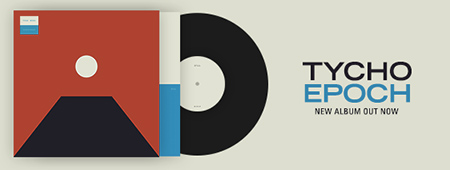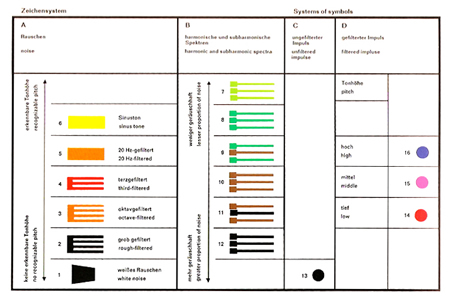Artikulation
Posted by Beamer
In 1956, György Ligeti composed an amazing electronic piece called “Artikulation”.
In 1970’s, Rainer Wehinger created a visual map to the recordings. Some awesome guy out there scanned the images and synced them with the audio. Thanks, guy!
More info:


11 Comments Leave A Comment
Karl Peterson says:
April 13, 2009 at 12:40 pmCan some please make some visual synth software like this? I want my next album art to be a portrait of the music itself. Beautiful.
Joaquim Marquès Nielsen says:
April 13, 2009 at 10:41 pmI swear I heard R2D2 at 3:34 :D
Jeff says:
April 14, 2009 at 3:17 amThe use of colors is so powerful. Had to wipe a tear.
Tardlovski says:
April 14, 2009 at 5:58 ambadass. glissandi is pretty wacky too. i was well into ligeti when i was younger. a good dude to know musically…beyond his uber-famous scores.
Nate says:
April 14, 2009 at 8:59 amI find it interesting that this work lacks musical quality – it listens more like a set of electro noise samples. I can not discern any melody or rhythm or rhyme or reason to the piece other than, of course, the fact that it was probably a novelty in the late 50’s. I wonder if it was meant as an experiment in sound or as a song? Possibly some form of an audio art piece. Nonetheless, this is a fascinating find and the “video score” is incredible.
rtificial says:
April 14, 2009 at 3:25 pmaww poo, my long post of links got ate by the intrawebs.
Micha says:
April 15, 2009 at 1:14 amTo Nate: it’s normal that you can’t discern any melody or rhythm, it’s the goal.
But to be clearer, there is rhythm, but “unmeasured” (no stable tempo, but an evoluting, free one), and there is only melody, but that you couldn’t easily sing (but could anyway, if you practise).
It’s an experiment of course (avant-garde), but is not a “song”. it is considered as the son of classical music, or contemporary music, (that is to say not pop), it’s a piece.
If you like it (music and score), check the french electronic music from the 50’s to now: the GRM (Groupe de Recherche Musical), Pierre Schaeffer, Pierre Henry, Musique concrete (http://en.wikipedia.org/wiki/Musique_concrete), Acousmatic Music (http://en.wikipedia.org/wiki/Acousmatic_music), and some of my favourite: Bernard Parmegiani, Christian Zanesi, François Bayle.
Nate says:
April 15, 2009 at 6:30 amThanks Micha – I’m going to check out those links.
I’m fascinated by the blurry line between “sound” and “music” and how one persons jumble of sound can be considered music to someone else – the aural equivalent of the age old “is that art” question.
Maybe its already been touched on in other posts, but it would be neat to get input from Scott or Jakub in this area since they deal in these realms. I think this would be a cool topic for some future post or project.
antoine caillet says:
April 17, 2009 at 12:24 pmfantastic work. thanks for sharing.
Micha says:
April 19, 2009 at 11:23 pm“the aural equivalent of the age old “is that art” question”
Another good question, simple and defintly with no universal answer: what is the definition of music?
If you try a dictionnary, it will either be so vague it doesn’t fit (“organized sounds”) or iit misses the point, you always know at least one music that doesn’t fit to it.
Tamara 3@1 says:
April 17, 2010 at 11:24 pm@Micha, I just have to concur so very much with you. The aural equivalent of the age old question indeed!
Music moves and inspires me, and I’ve lately been exposed to so much new musical information that it is like being a child all over again. I really thought I had a good handle on what “music” is, but after all the paradigm shifting of late I can not help but admit that I know nothing, and that what I’ve learned but scratches the surface of what is out there.
The thing with music is also that it is ever-evolving, and never remains static. Now try pin that one down!